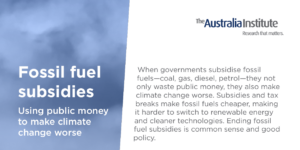Nothing captures prime minister Scott Morrison’s approach to climate change better than his embrace of “clean hydrogen” – a BS marketing term that delivers nothing but obfuscation and helps no one but the fossil fuel industry. Tellingly, this approach isn’t even new: Morrison has simply dusted off an old polluter playbook and changed a few of the nouns.
The idea of “clean coal” first showed up around 20 years ago, when its early salespeople assured us that there was no need to stop building new coal mines or coal-fired power stations because, one day soon, new technology would allow us to collect the carbon dioxide released from the burning of fossil fuels and bury it safely underground. One day. Soon.
Like filters on cigarettes and real fruit juice in our soft drink, the power of new technologies like “clean coal” is that it allowed people (mainly Howard government ministers) to pretend there was no need to stop investing in fossil fuel projects that cause climate change, or to rapidly roll out existing technologies like solar, wind and storage such as pumped hydro.
In 2001 the Howard government created the National Energy Policy, to provide an overarching framework for climate policy. By 2002, back when our modems made a loud noise as they connected the internet, we formed the US-Australia Climate Action Partnership which included the first subsidies for carbon capture and storage (CCS). Howard even included CCS in the “National Research Priorities” he outlined that year. Morrison isn’t even the first PM to master the fake climate announcable.
But, as years and billions of public dollars slipped away, the consensus view on CCS shifted steadily from “might as well try” to “they are taking the piss”.
In a 2009 debate with the head of the Australian Coal Association, Ralph Hillman, I said: “Nothing’s changed since the (Prime Minister’s Science, Engineering and Innovation Council) report in 2002 … Hope is not a strategy, and I hope that someone can invent clean coal. I hope that it’s affordable. The issue is how are we going to spend the next 10 or 15 years? Not just in terms of research, but in investment. What are we going to start building tomorrow, when the evidence suggests if we don’t make serious emission reductions in the next 15 years, the capacity to keep our emissions within the carbon budget that delivers a stable climate is evaporating, it’s slipping through our fingers as we speak.”
But despite 20 years of CCS being “10 years away”, the prime minister recently decided to apply a deep green coat of “CCS optimism” and announced that the latest excuse for still building new coal mines and coal-fired power stations is that we are now working on “clean hydrogen” made by burning fossil fuel and, you guessed it, planning to bury the emissions under the ground. One day. Soon.
While it’s possible to produce clean hydrogen, right now, with renewable energy, Morrison – like Howard and Tony Abbott before him – is determined to focus on the potential for coal and gas to generate hydrogen as, in doing so, we can keep pretending that the world is going to need more of our coal and gas in the coming decades, not less.
It really is bizarre how close the overlap is between the rightwingers who had no faith in the ability of climate scientists to predict climate change and the rightwingers who have incredible faith in other scientists’ ability to invent technological solutions to climate change. Non-renewable solutions, that is.
Many of the same folk who think that batteries and pumped hydro storage are unreliable are confident we can bury carbon dioxide underground for thousands of years with no chance it could ever bubble up. And those same folk who rage against the cost of renewables are unconcerned about the cost of nuclear energy, new coal-fired power stations and, of course, CCS. And just why CCS was abandoned by the coal and electricity-fired electricity sector but is expected to work for the coal- and gas-fired hydrogen sector is the question the PM is yet to be asked. Not that he would answer if he was.
Of course, dodgy science claims aren’t the only old trick the Morrison government has been recycling. The prime minister’s head of the manufacturing taskforce for the National Covid-19 Coordination Commission, and architect of the so-called gas-fired recovery plan, Andrew Liveris, went on the ABC’s Q+A recently to talk up all of the jobs that depend on the fossil fuel industry. To a bemused panel and an enraged audience Liveris wrongly claimed that 850,000 people were employed in the plastic, fertiliser and other industries that used gas as a “feedstock” into their production (as distinct from as a fuel in their factories). When former prime minister Malcolm Turnbull challenged the absurdity of his claim, Liveris doubled down. But the data makes clear that despite Liveris’ confidence he was wrong.
According to an ACIL Allen report (2019) commissioned by Chemistry Australia only 9,232 of Australia’s workforce of 11 million work in industries that use gas a feedstock in their manufacturing process. The most recent ABS data suggests direct employment in those industries employs, at a stretch, 14,000.
In the private sector, a CEO that kept spending money on imaginary technologies or who completely misunderstood the potential benefits of their product would be removed by their board or their shareholders. But it’s not the invisible hand of market forces that drives Australia’s obsession with fossil fuels, CCS and gas-fired recoveries, it’s the visible hand of government. Research released last week by The Australia Institute shows that Australian governments spend more money each year subsidising fossil fuels than we spend on the army.
The idea of Carbon Capture and Storage, and the “clean coal” and “clean hydrogen” that could come with it, will never go away for two simple reasons: we can keep researching it forever because it will never be invented and it works as a cover story for fossil fuels whether we invent it or not.
Between the Lines Newsletter
The biggest stories and the best analysis from the team at the Australia Institute, delivered to your inbox every fortnight.
You might also like
Fossil fuel subsidies
When governments subsidise fossil fuels—coal, gas, diesel, petrol—they not only waste public money, they also make climate change worse. Subsidies and tax breaks make fossil fuels cheaper, making it harder to switch to renewable energy and cleaner technologies. Ending fossil fuel subsidies is common sense and good policy.
Japan and Australia’s gas-fuelled obsession endures under Asia Zero Emission Community
Japan and Australia enjoy a long-standing relationship when it comes to energy trade. According to Japan, “(t)he energy and resources sector is the bedrock of the Japan-Australia economic partnership”. But the two countries’ efforts to decarbonise their economies to reach their respective emissions reduction targets have been threatening to jeopardise this gas-fuelled obsession. Japan has
Why a fossil fuel-free COP could put Australia’s bid over the edge
When the medical world hosts a conference on quitting smoking, they don’t invite Phillip Morris, or British American Tobacco along to help “be part of the solution”.



